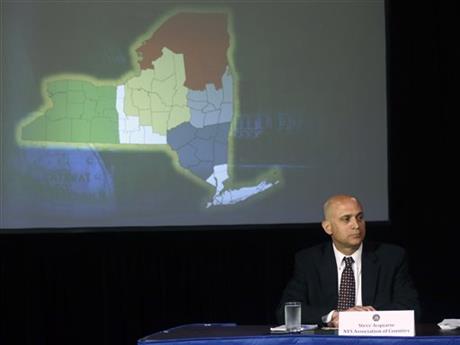
By MICHAEL GORMLEY
FILE – In this May 9, 2013 file photo, Stephen Acquario, executive director of the New York State Association of Counties, attends a news conference in the Red Room at the Capitol in Albany, N.Y. Acquario is among hundreds of lobbyists in at least 20 states who get public pensions because they represent associations of counties, cities and school boards, an Associated Press review found. (AP Photo/Mike Groll, File)
ALBANY, N.Y. (AP) — As a lobbyist in New York’s statehouse, Stephen Acquario is doing pretty well. He pulls down $204,000 a year, more than the governor makes, gets a Ford Explorer as his company car and is afforded another special perk:
Even though he’s not a government employee, he is entitled to a full state pension.
He’s among hundreds of lobbyists in at least 20 states who get public pensions because they represent associations of counties, cities and school boards, an Associated Press review found. Legislatures granted them access decades ago on the premise that they serve governments and the public. In many cases, such access also includes state health care benefits.
But several states have started to question whether these organizations should qualify for such benefits, since they are private entities in most respects: They face no public oversight of their activities, can pay their top executives private-sector salaries and sometimes lobby for positions in conflict with taxpayers. New Jersey and Illinois are among the states considering legislation that would end their inclusion.
“It’s a question of, ‘Why are we providing government pensions to these private organizations?'” said Illinois Democratic Rep. Elaine Nekritz.
Acquario, executive director and general counsel of the New York State Association of Counties, argues that his group gives local government a voice in the statehouse, and the perk of a state pension makes it easier to hire people with government expertise.
“We want the people that work in local governments to continue to be part of the solution,” he said. “We represent the same taxpayers.”
The debate is more about principle than big money, since the staffs of such organizations are relatively small and make barely a ripple in huge state retirement systems. The eight New York associations, for example, have fewer than 120 total employees out of 633,100 current workers in the state’s $158.7 billion pension system.
Still, the issue raises a public policy question as many states and taxpayers struggle to fund their pension obligations required by law.
“There is liability for taxpayers,” said Keith Brainard, research director of the National Association of State Retirement Administrators. “Providing a pension benefit involves some amount of risk for the state and when you provide access to employees of entities that are not in control of the state.”
Unlike state government, for example, these groups aren’t bound by salary restrictions — significant salary increases would result in increasing pension benefits.
New York Conference of Mayors Executive Director Peter Baynes, who makes $196,000 a year and gets a 2012 Jeep Grand Cherokee, argues that his and other associations have been at the fore of pushing to reduce taxpayers’ costs, including reducing the costs of the pension system they share.
New York lawmakers recently acted to reduce benefits for future government hires and are proposing 401(k) savings programs for employees instead of traditional pensions.
But such cuts won’t affect Baynes. Under the New York Constitution and that of most states, the benefits of those already in the pension system are protected from future cuts.
“It’s clear that there’s a big problem with hypocrisy when these lobbyists have been pushing austerity and benefit cuts for other government workers while they themselves enjoy solid state pensions,” said Michael Kink of the progressive group Strong Economy for All Coalition. “‘Do as I say, not as I do’ seems to be their approach on retirement cuts.”
“Workers who have faced cuts in pay and pensioners have a right to be angry — as do voters,” Kink said.
In many states, lobbying groups for states and counties take positions that could conflict with taxpayer interests, such as advocating to weaken caps on property tax increases and boosting state school aid.
But associations of cities, counties and school boards argue that a plausible case can be made for allowing them to get state pensions. These quasi-government organizations operate mostly or solely on dues from their members — local governments or school boards typically — which are paid out of taxpayer-funded budgets. They argue they pool their resources to give a voice to government entities that serve taxpayers.
“It’s a technical truism that lobbying groups are not supposed to be in the system,” said Richard Brodsky, a former New York assemblyman. “But what they are doing is carrying out missions assigned to them by public officials in the public interest as they understand it.”
Which groups get the pension benefit vary widely across the nation.
In Colorado, the list includes the Colorado High School Activities Associations, which runs state sports tournaments. Alabama gives it to the state affiliate of the National Education Association teachers’ union. Washington state includes the Washington Apple Commission, which operates like a trade group. North Carolina’s state Athletic Coaches Association is included, as is Tennessee’s private Industry Council.
New York lawmakers decided years ago to bar any more lobbying and nonprofit groups in the pension system, grandfathering in eight groups.
New Jersey Gov. Chris Christie, who supports legislation to cut future hires from such groups out of his state’s pension, issued an executive order this month creating a Pension Fraud and Abuse Unit. Among its mandates is to look at “claims of improper participation in the retirement systems.”



